
Illustrative Math Alignment: Grade 6 Unit 1
Reasoning to Find Area
Lesson 1: Tiling the Plane
Use the following Media4Math resources with this Illustrative Math lesson.
| Thumbnail Image | Title | Body | Curriculum Nodes |
|---|---|---|---|

|
Math Example--Area and Perimeter--Rectangle Area with Tiles--Example 1 |
Rectangle Area with Tiles--Example 1TopicArea and Perimeter DescriptionThis example demonstrates finding the area of a rectangle using unit tiles. The image shows a rectangle completely filled with tiles, where each tile represents one unit of area. To calculate the area, count the total number of tiles that cover the rectangle. This visual method helps students understand the concept of area as the total number of unit squares within a shape. It reinforces the understanding of area calculation by providing a tangible way to count and verify the space covered by the rectangle. |
Area and Perimeter of Quadrilaterals |
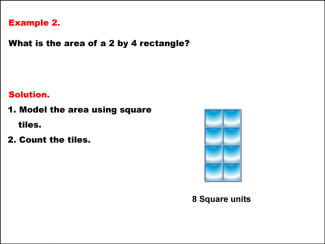
|
Math Example--Area and Perimeter--Rectangle Area with Tiles--Example 2 |
Rectangle Area with Tiles--Example 2TopicArea and Perimeter DescriptionThis example demonstrates finding the area of a rectangle using unit tiles. The image shows a rectangle completely filled with tiles, where each tile represents one unit of area. To calculate the area, count the total number of tiles that cover the rectangle. This visual method helps students understand the concept of area as the total number of unit squares within a shape. It reinforces the understanding of area calculation by providing a tangible way to count and verify the space covered by the rectangle. |
Area and Perimeter of Quadrilaterals |
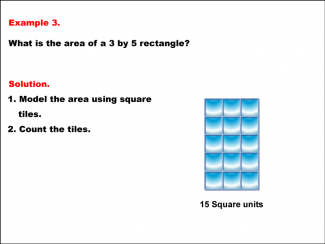
|
Math Example--Area and Perimeter--Rectangle Area with Tiles--Example 3 |
Rectangle Area with Tiles--Example 3TopicArea and Perimeter DescriptionThis example demonstrates finding the area of a rectangle using unit tiles. The image shows a rectangle completely filled with tiles, where each tile represents one unit of area. To calculate the area, count the total number of tiles that cover the rectangle. This visual method helps students understand the concept of area as the total number of unit squares within a shape. It reinforces the understanding of area calculation by providing a tangible way to count and verify the space covered by the rectangle. |
Area and Perimeter of Quadrilaterals |
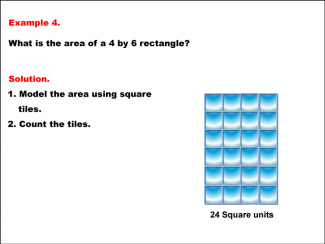
|
Math Example--Area and Perimeter--Rectangle Area with Tiles--Example 4 |
Rectangle Area with Tiles--Example 4TopicArea and Perimeter DescriptionThis example demonstrates finding the area of a rectangle using unit tiles. The image shows a rectangle completely filled with tiles, where each tile represents one unit of area. To calculate the area, count the total number of tiles that cover the rectangle. This visual method helps students understand the concept of area as the total number of unit squares within a shape. It reinforces the understanding of area calculation by providing a tangible way to count and verify the space covered by the rectangle. |
Area and Perimeter of Quadrilaterals |

|
Math Example--Area and Perimeter--Rectangle Area with Tiles--Example 5 |
Rectangle Area with Tiles--Example 5TopicArea and Perimeter DescriptionThis example demonstrates finding the area of a rectangle using unit tiles. The image shows a rectangle completely filled with tiles, where each tile represents one unit of area. To calculate the area, count the total number of tiles that cover the rectangle. This visual method helps students understand the concept of area as the total number of unit squares within a shape. It reinforces the understanding of area calculation by providing a tangible way to count and verify the space covered by the rectangle. |
Area and Perimeter of Quadrilaterals |
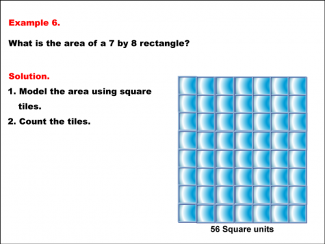
|
Math Example--Area and Perimeter--Rectangle Area with Tiles--Example 6 |
Rectangle Area with Tiles--Example 6TopicArea and Perimeter DescriptionThis example demonstrates finding the area of a rectangle using unit tiles. The image shows a rectangle completely filled with tiles, where each tile represents one unit of area. To calculate the area, count the total number of tiles that cover the rectangle. This visual method helps students understand the concept of area as the total number of unit squares within a shape. It reinforces the understanding of area calculation by providing a tangible way to count and verify the space covered by the rectangle. |
Area and Perimeter of Quadrilaterals |
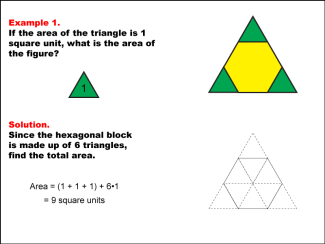
|
Math Examples: Area with Pattern Blocks: Example 1 |
Math Examples: Area with Pattern Blocks: Example 1TopicGeometry DescriptionThis example demonstrates the calculation of area using pattern blocks. A hexagonal figure is composed of six triangles, each with an area of 1 square unit. The total area of the figure is determined by summing the areas of all triangles, resulting in 6 square units. |
Applications of Polygons |
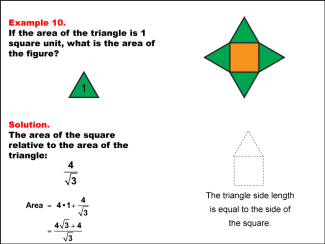
|
Math Examples: Area with Pattern Blocks: Example 10 |
Math Examples: Area with Pattern Blocks: Example 10TopicGeometry DescriptionThis example features a triangle with an area of 1 square unit and a similar composite figure as in Example 9, consisting of a central square and four surrounding triangles forming a star-like shape. The triangle's side length equals that of the square, contributing an additional 4/sqrt(3) units for a total area expressed as (4 * sqrt(3) + 4)/sqrt(3) square units. |
Applications of Polygons |

|
Math Examples: Area with Pattern Blocks: Example 2 |
Math Examples: Area with Pattern Blocks: Example 2TopicGeometry DescriptionThis example explores area calculation using a hexagonal figure composed of two trapezoids and three triangles. The trapezoids each have an area of 1 square unit, while the triangles contribute to the overall shape. The total area is determined by adding the areas of the trapezoids and triangles, resulting in 5 square units. |
Applications of Polygons |
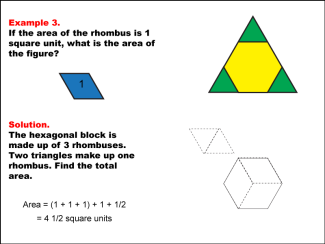
|
Math Examples: Area with Pattern Blocks: Example 3 |
Math Examples: Area with Pattern Blocks: Example 3TopicGeometry DescriptionThis example illustrates area calculation using a hexagonal figure made up of three rhombuses and two triangles. Each rhombus has an area of 1 square unit, while each triangle contributes half a rhombus to the overall shape. The total area is calculated by summing the areas of the rhombuses and triangles, resulting in 4.5 square units. |
Applications of Polygons |
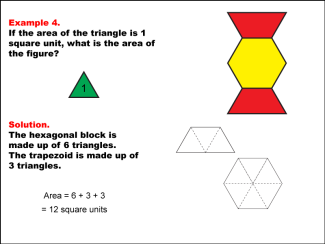
|
Math Examples: Area with Pattern Blocks: Example 4 |
Math Examples: Area with Pattern Blocks: Example 4TopicGeometry DescriptionThis example demonstrates area calculation using a hexagonal figure flanked by two trapezoids. Each triangle within the shape has an area of 1 square unit, and each trapezoid is composed of three triangles. The total area is determined by summing the areas of all components, resulting in 12 square units. Pattern blocks are effective tools for teaching geometry, allowing students to physically manipulate shapes and understand their properties. This collection of examples illustrates how different combinations of shapes can form larger figures, reinforcing concepts of area addition and spatial reasoning. |
Applications of Polygons |
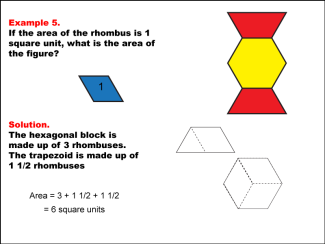
|
Math Examples: Area with Pattern Blocks: Example 5 |
Math Examples: Area with Pattern Blocks: Example 5TopicGeometry DescriptionThis example explores area calculation using a hexagonal block composed of three rhombuses and two trapezoids. Each rhombus has an area of 1 square unit, and each trapezoid is equivalent to 1 1/2 rhombuses. The total area is determined by summing the areas of all components, resulting in 6 square units. |
Applications of Polygons |
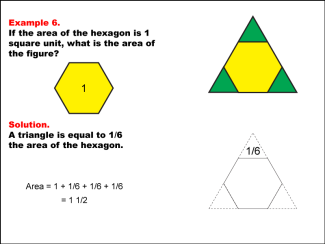
|
Math Examples: Area with Pattern Blocks: Example 6 |
Math Examples: Area with Pattern Blocks: Example 6TopicGeometry DescriptionThis example features a hexagon with three surrounding triangles. Each triangle is equal to 1/6 of the hexagon's area. The total area of the figure is calculated by adding the area of the hexagon and the triangles, resulting in 1 1/2 square units. Pattern blocks are excellent tools for teaching geometry, particularly in understanding area. By manipulating these shapes, students can visualize how different parts contribute to the whole. This collection of examples provides varied configurations of shapes, helping students explore geometric relationships and area calculations. |
Applications of Polygons |
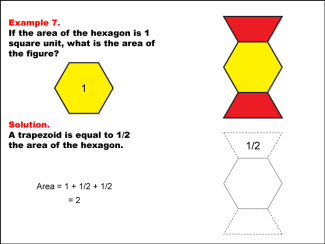
|
Math Examples: Area with Pattern Blocks: Example 7 |
Math Examples: Area with Pattern Blocks: Example 7TopicGeometry DescriptionThis example displays a hexagon with two trapezoids attached on opposite sides. Each trapezoid is equal to 1/2 the area of the hexagon. The total area of the figure is calculated by adding the areas of the hexagon and trapezoids, resulting in 2 square units. Using pattern blocks helps students understand geometric concepts like area by providing a hands-on learning experience. This collection of examples demonstrates how different shapes can be combined to form larger figures, reinforcing spatial reasoning and addition of areas. |
Applications of Polygons |
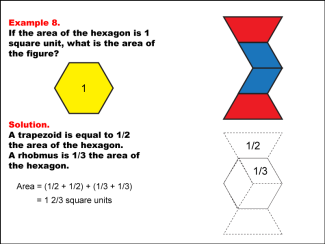
|
Math Examples: Area with Pattern Blocks: Example 8 |
Math Examples: Area with Pattern Blocks: Example 8TopicGeometry DescriptionThis example depicts a pattern with two trapezoids and two rhombuses stacked vertically. Each trapezoid is equal to 1/2, and each rhombus is equal to 1/3 of the hexagon's area. The total area is calculated as 1 2/3 square units. Pattern blocks allow students to explore geometry concepts such as area through tangible manipulation of shapes. This series of examples highlights how different shapes can be combined, reinforcing understanding of spatial relationships and arithmetic operations involving areas. |
Applications of Polygons |
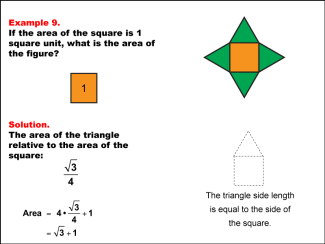
|
Math Examples: Area with Pattern Blocks: Example 9 |
Math Examples: Area with Pattern Blocks: Example 9TopicGeometry DescriptionThis example shows a square with an area of 1 square unit and a composite figure made up of a central square and four surrounding triangles forming a star-like shape. The triangle's side length equals that of the square, contributing an additional sqrt(3) units for a total area of sqrt(3) + 1 square units. |
Applications of Polygons |